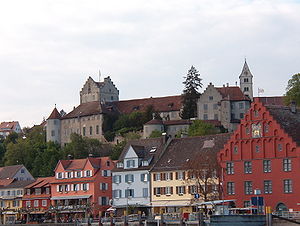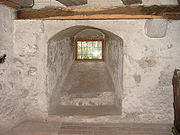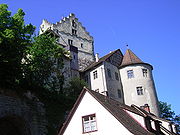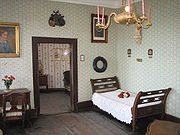
Burg Meersburg
Encyclopedia



Meersburg
Meersburg is a town of Baden-Württemberg in the southwest of Germany at Lake Constance.It is famous for its charming medieval city. The lower town and upper town are reserved for pedestrians only and connected by two stairways and a steep street .-History:The name of the town means "Burg on the...
on Lake Constance
Lake Constance
Lake Constance is a lake on the Rhine at the northern foot of the Alps, and consists of three bodies of water: the Obersee , the Untersee , and a connecting stretch of the Rhine, called the Seerhein.The lake is situated in Germany, Switzerland and Austria near the Alps...
in Baden-Württemberg, Germany is the oldest inhabited castle in Germany. The central tower was first built during the 7th century, though the original structure is no longer visible. Burg Meersburg is known as the old castle, in the reference to the neighboring 18th century New Castle
Neues Schloss (Meersburg)
The Neues Schloss Meersburg is located in Meersburg near Lake Constance in Baden-Württemberg, Germany. From its construction in 1750 until the bishopric was dissolved in 1803 it was the seat of the Prince-Bishop of Constance....
.
Location
The Burg Meersburg is located on a rocky outcropping near Lake Constance (German: Bodensee). The castle is located about 440 m above sea level and towers above the Lower City, but is about level with the rest of the city.Construction theories
There are two theories about the construction of the Meersburg. The first is that the Merovingian king Dagobert IDagobert I
Dagobert I was the king of Austrasia , king of all the Franks , and king of Neustria and Burgundy . He was the last Merovingian dynast to wield any real royal power...
built the Dagobertturm (Dagobert's Tower), the central keep
Keep
A keep is a type of fortified tower built within castles during the Middle Ages by European nobility. Scholars have debated the scope of the word keep, but usually consider it to refer to large towers in castles that were fortified residences, used as a refuge of last resort should the rest of the...
of the Meersburg, in 630. Around 630, Dagobert was in the Lake Constance region working on the Christianization
Germanic Christianity
The Germanic people underwent gradual Christianization in the course of Late Antiquity and the Early Middle Ages. By the 8th century, England and the Frankish Empire were Christian, and by AD 1100 Germanic paganism had also ceased to have political influence in Scandinavia.-History:In the 4th...
of the Alamanni
Alamanni
The Alamanni, Allemanni, or Alemanni were originally an alliance of Germanic tribes located around the upper Rhine river . One of the earliest references to them is the cognomen Alamannicus assumed by Roman Emperor Caracalla, who ruled the Roman Empire from 211 to 217 and claimed thereby to be...
.. This theory is based on a source from 1548, and was supported by Joseph von Laßberg who lived in the castle during the 19th century. A charter issued by Frederick Barbarossa
Frederick I, Holy Roman Emperor
Frederick I Barbarossa was a German Holy Roman Emperor. He was elected King of Germany at Frankfurt on 4 March 1152 and crowned in Aachen on 9 March, crowned King of Italy in Pavia in 1155, and finally crowned Roman Emperor by Pope Adrian IV, on 18 June 1155, and two years later in 1157 the term...
on 27 November 1155, citing older, questionable sources, mentions that the boundaries of the Bishopric of Constance
Bishopric of Constance
The Bishopric of Constance was a diocese of the Roman Catholic Church and ecclesiastical state of the Holy Roman Empire that existed from about 585 until 1821. Its seat was Konstanz at the western end of Lake Constance in the south-west corner of Germany...
were established by Dagobert himself indicating that Dagobert was personally involved in establishing rulers in the region.
The second theory is that the castle was built in the early 12th century, and based on the name of the tower an association with the earlier Merovingian king was created. It is based on the observation that in the Lake Constance region there are no records of any castles being founded in the 7th century, but in the 12th century to early 13th century many castles were built in the region. The Merdesburch Castle was first mentioned in 1113, which implies a construction date before the early 12th century.
The stones at the base of the Dagobertturm are very large roughly squared stones that according to architectural history
Architectural History
Architectural History is the main journal of the Society of Architectural Historians of Great Britain .The journal is published each autumn. The architecture of the British Isles is a major theme of the journal, although it includes more general papers on the history of architecture. Member of...
could date from either the 7th century or from the 12th century to early 13th century. Because the stones could have come from either era, it is not clear which theory is correct. However, similarities between the Meersburg and other 12th century castles have been noted.
Joseph von Laßberg also presents the theory that the tower was built on the site of an earlier destroyed castle. He states that the castle was destroyed by Duke Gottfried of Alemannia who was at war with Dagobert's successor and rebuilt 80 years later by Charles Martel
Charles Martel
Charles Martel , also known as Charles the Hammer, was a Frankish military and political leader, who served as Mayor of the Palace under the Merovingian kings and ruled de facto during an interregnum at the end of his life, using the title Duke and Prince of the Franks. In 739 he was offered the...
. From 730 until 911 the Meersburg was a Carolingian
Carolingian
The Carolingian dynasty was a Frankish noble family with origins in the Arnulfing and Pippinid clans of the 7th century AD. The name "Carolingian", Medieval Latin karolingi, an altered form of an unattested Old High German *karling, kerling The Carolingian dynasty (known variously as the...
castle and owned by the Counts of Linzgau
Linzgau
Linzgau is a region in southern Germany in the state of Baden-Württemberg north of Lake Constance and south of the Danube valley. It is bounded by Lake Constance on the south, the Hegau on the west, the Danube valley on the north, and the Schussen River on the east.It reaches east as far as...
, but administered by the Counts of Buchhorn. Following the extinction of the Buchhorn line it would have passed to the Counts of Guelph
Guelphs and Ghibellines
The Guelphs and Ghibellines were factions supporting the Pope and the Holy Roman Emperor, respectively, in central and northern Italy. During the 12th and 13th centuries, the split between these two parties was a particularly important aspect of the internal policy of the Italian city-states...
. A contract between the Counts of Guelph and the Bishopric of Constance indicated that the Meersburg would be given to the Bishopric if the count died without any male heirs. It appears that the Guelphs and the Bishporic had close ties, as Bishop Conrad
Conrad of Constance
-Life:Conrad was a member of the powerful Welf family, son of Count Heinrich of Altdorf. After an education at the cathedral school in Constance, he became provost of Constance Cathedral and in 934 was made Bishop of Constance....
was of Guelph descent.
Seat of the Prince-Bishops of Constance

Frederick II, Holy Roman Emperor
Frederick II , was one of the most powerful Holy Roman Emperors of the Middle Ages and head of the House of Hohenstaufen. His political and cultural ambitions, based in Sicily and stretching through Italy to Germany, and even to Jerusalem, were enormous...
celebrated the Holy Week
Holy Week
Holy Week in Christianity is the last week of Lent and the week before Easter...
in Meersburg. Then, in 1233 Meersburg was granted the weekly market right
Market town
Market town or market right is a legal term, originating in the medieval period, for a European settlement that has the right to host markets, distinguishing it from a village and city...
by Frederick II. Shortly before his death in 1254, Conrad IV
Conrad IV of Germany
Conrad IV was king of Jerusalem , of Germany , and of Sicily .-Biography:...
, having been deposed and excommunicated
Excommunication
Excommunication is a religious censure used to deprive, suspend or limit membership in a religious community. The word means putting [someone] out of communion. In some religions, excommunication includes spiritual condemnation of the member or group...
by Pope Innocent IV
Pope Innocent IV
Pope Innocent IV , born Sinibaldo Fieschi, was pope from June 25, 1243 until his death in 1254.-Early life:...
asked Eberhard II, the High Steward of Meersburg to care for his two year old sonConradin
Conradin
Conrad , called the Younger or the Boy, but usually known by the diminutive Conradin , was the Duke of Swabia , King of Jerusalem , and King of Sicily .-Early childhood:Conradin was born in Wolfstein, Bavaria, to Conrad...
. In 1261 Conradin became the Duke of Swabia
Duke of Swabia
The following is a list of Dukes of Swabia in southwest Germany.Swabia was one of the five stem duchies of the medieval German kingdom, and its dukes were thus among the most powerful magnates of Germany. The most notable family to hold Swabia were the Hohenstaufen, who held it, with a brief...
, raising an army in the Ravensburg
Ravensburg
Ravensburg is a town in Upper Swabia in Southern Germany, capital of the district of Ravensburg, Baden-Württemberg.Ravensburg was first mentioned in 1088. In the Middle Ages, it was an Imperial Free City and an important trading centre...
area. He departed from Meersburg to head south into Italy
Italy
Italy , officially the Italian Republic languages]] under the European Charter for Regional or Minority Languages. In each of these, Italy's official name is as follows:;;;;;;;;), is a unitary parliamentary republic in South-Central Europe. To the north it borders France, Switzerland, Austria and...
to fight Charles I of Anjou and attempt to reclaim the titles stripped by the Pope from his father. While Conradin was able to take Rome, he was soon afterward captured and executed.

However, even as a residence for a Bishop, the Meersburg was the site of several battles over the following centuries. In 1334, there were two candidates for the position of Bishop of Constance. Baron Nikolaus I of Kenzingen
Kenzingen
Kenzingen is a town in the district of Emmendingen, in Baden-Württemberg, Germany. It is situated on the river Elz, 23 km north of Freiburg.-External links:*...
was elected Bishop by supporters of the Pope while Albrecht of Hohenberg
Hohenberg
Hohenberg may refer to:*the Austrian Ducal family of Hohenberg who are descended from the Austrian Imperial and Royal Habsburg-Lorraine dynasty*Hohenberg, Lower Austria, a town in Austria*Hohenberg an der Eger, a town in Bavaria, Germany...
was chosen by the Holy Roman Emperor
Holy Roman Emperor
The Holy Roman Emperor is a term used by historians to denote a medieval ruler who, as German King, had also received the title of "Emperor of the Romans" from the Pope...
. Nikolaus quickly traveled to Avignon
Avignon Papacy
The Avignon Papacy was the period from 1309 to 1376 during which seven Popes resided in Avignon, in modern-day France. This arose from the conflict between the Papacy and the French crown....
, in France the seat of Pope John XXII
Pope John XXII
Pope John XXII , born Jacques Duèze , was pope from 1316 to 1334. He was the second Pope of the Avignon Papacy , elected by a conclave in Lyon assembled by Philip V of France...
to have his appointment confirmed. He then returned to Meersburg and quickly had the defenses improved. Albrecht, meanwhile, had raised an army from the southern German princes and was joined by an Imperial army led by the Emperor. During the summer of 1334, the Imperial army besieged
Siege
A siege is a military blockade of a city or fortress with the intent of conquering by attrition or assault. The term derives from sedere, Latin for "to sit". Generally speaking, siege warfare is a form of constant, low intensity conflict characterized by one party holding a strong, static...
Burg Meersburg. During the siege, cannon
Cannon
A cannon is any piece of artillery that uses gunpowder or other usually explosive-based propellents to launch a projectile. Cannon vary in caliber, range, mobility, rate of fire, angle of fire, and firepower; different forms of cannon combine and balance these attributes in varying degrees,...
s were used for the first time in Germany. However, even with the new gunpowder weapons the Imperial troops were unable to take the castle. At the end of August, Emperor Louis IV
Louis IV, Holy Roman Emperor
Louis IV , called the Bavarian, of the house of Wittelsbach, was the King of Germany from 1314, the King of Italy from 1327 and the Holy Roman Emperor from 1328....
was growing tired of the siege. When Duke Otto of Austria
Otto, Duke of Austria
Otto IV, the Merry was a Duke of Austria and the youngest son of Albert I of Germany and Elisabeth of Tirol.Otto was born in Vienna. He had two brothers, namely Frederick the Handsome and Albert II...
requested his help against the Bohemian
Bohemian
A Bohemian is a resident of the former Kingdom of Bohemia, either in a narrow sense as the region of Bohemia proper or in a wider meaning as the whole country, now known as the Czech Republic. The word "Bohemian" was used to denote the Czech people as well as the Czech language before the word...
s, Louis left Meersburg and confirmed Nikolaus as Bishop. Albrecht was granted the Bishopric of Würzburg
Bishopric of Würzburg
The Bishopric of Würzburg was a prince-bishopric in the Holy Roman Empire, located in Lower Franconia, around the city of Würzburg, Germany. Würzburg was a diocese from 743. In the 18th century, its bishop was often also Bishop of Bamberg...
in 1345 to replace the lost Bishopric.
Following Nikolaus, Urich Pfefferhardt was Bishop from 1345 until 1351. In 1352 Johann III Windlock from Constance
Konstanz
Konstanz is a university city with approximately 80,000 inhabitants located at the western end of Lake Constance in the south-west corner of Germany, bordering Switzerland. The city houses the University of Konstanz.-Location:...
was installed at the castle, he proved to be an autocratic ruler and was disliked by the people and local nobles. Following a dispute with Konrad of Homberg
Homberg
-In Germany:*Homberg , administrative seat of Schwalm-Eder-Kreis, Hesse*Homberg , in the district of Vogelsbergkreis, Hesse*Homberg, Westerwaldkreis, in the district of Westerwaldkreis, Rhineland-Palatinate...
-Markdorf
Markdorf
Markdorf is a town in the Bodensee district, in Baden-Württemberg, Southern Germany. It is situated near Lake Constance, 10 km northwest of Friedrichshafen....
and the Abbot
Abbot
The word abbot, meaning father, is a title given to the head of a monastery in various traditions, including Christianity. The office may also be given as an honorary title to a clergyman who is not actually the head of a monastery...
Eberhard of Reichenau
Reichenau Island
Reichenau Island lies in Lake Constance in southern Germany, at approximately . It lies between Gnadensee and Untersee, two parts of Lake Constance, almost due west of the city of Konstanz. The island is connected to the mainland by a causeway that was completed in 1838...
, he was killed by soldiers while in his palace in Constance.

Italian coin florin
The Italian florin was a coin struck from 1252 to 1533 with no significant change in its design or metal content standard. It had 54 grains of nominally pure gold worth approximately 200 modern US Dollars...
for breaking the peace within the castle grounds. Later attempts by the town to secure Free Imperial City
Free Imperial City
In the Holy Roman Empire, a free imperial city was a city formally ruled by the emperor only — as opposed to the majority of cities in the Empire, which were governed by one of the many princes of the Empire, such as dukes or prince-bishops...
status led to further hostilities in 1457. The inhabitants of the city stormed the castle and captured it. Bishop Heinrich responded by besieging the city. Following intervention by Siegmund of Austria
Sigismund, Archduke of Austria
Sigismund of Austria, Duke, then Archduke of Further Austria was a Habsburg archduke of Austria and ruler of Tirol from 1446 to 1490....
as well as Constance and Zürich
Zürich
Zurich is the largest city in Switzerland and the capital of the canton of Zurich. It is located in central Switzerland at the northwestern tip of Lake Zurich...
a compromise was reached. Heinrich then withdrew, but attacked the city a short while later. Catching the citizens off guard, his soldiers stormed the city and captured all the leaders of the revolution. Heinrich executed the leaders of the rebellion and stripped rights away from the city.
The Crow-stepped gable
Crow-stepped gable
A Stepped gable, Crow-stepped gable, or Corbie step is a stair-step type of design at the top of the triangular gable-end of a building...
(a stepped roof line instead of a smooth roof line) on the tower was added by the Constance Prince-Bishop Hugo von Hohenlandenberg
Hugo von Hohenlandenberg
Hugo von Hohenlandenberg was Bishop of Konstanz from 1496 to 1529, and again in 1530 and 1531 until his death in 1532.-Biography:...
(Served 1496–1532). Before his time, the Meersburg was a summer residence of the bishops. Following a conflict with the city of Constance in 1526, Hugo moved to the Meersburg. The castle remained the bishops' primary residence until the move to the New Schloss in the 18th century.
In 1647 the castle was attacked by Swedish troops
Swedish Empire
The Swedish Empire refers to the Kingdom of Sweden between 1561 and 1721 . During this time, Sweden was one of the great European powers. In Swedish, the period is called Stormaktstiden, literally meaning "the Great Power Era"...
during the Thirty Years' War
Thirty Years' War
The Thirty Years' War was fought primarily in what is now Germany, and at various points involved most countries in Europe. It was one of the most destructive conflicts in European history....
, however only the roof timbers were burned during the attack.
During the beginning of the 18th century, the bishops began to build the New Castle at Meersburg
Neues Schloss (Meersburg)
The Neues Schloss Meersburg is located in Meersburg near Lake Constance in Baden-Württemberg, Germany. From its construction in 1750 until the bishopric was dissolved in 1803 it was the seat of the Prince-Bishop of Constance....
as a modern residence castle. After 1750 the old castle served as a house for the administration of the city.
Secularization

.jpg)
German Mediatisation
The German Mediatisation was the series of mediatisations and secularisations that occurred in Germany between 1795 and 1814, during the latter part of the era of the French Revolution and then the Napoleonic Era....
of 1803 the Meersburg came under the control of the Grand Duchy of Baden
Grand Duchy of Baden
The Grand Duchy of Baden was a historical state in the southwest of Germany, on the east bank of the Rhine. It existed between 1806 and 1918.-History:...
. In 1838 the Grand Duke sold the castle to a private owner. The collector Joseph von Laßberg and his wife Maria Anna von Droste-Hülshoff, who was also called Jenny, acquired the castle. In 1841 Jenny's sister Annette von Droste-Hülshoff
Annette von Droste-Hülshoff
Anna Elisabeth von Droste-Hülshoff, known as Annette von Droste-Hülshoff , was a 19th century German author, and one of the most important German poets.-Biography:...
, the famous German poetess, moved to the castle where she would spend the last eight years of her life. In the castle she wrote her 1841–42 poem Das Alte Schloss (English: The Old Castle). Which included the lines Auf der Burg haus´ ich am Berge, Unter mir der blaue See... (I live upon the castle on the mountain, the blue lake lies below...). Following the death of the Laßbergs, the castle went to their twin daughters, Hildegard and Hildegunde. However they couldn't afford the upkeep and sold the castle in 1877. Karl Mayer von Mayerfels from Munich
Munich
Munich The city's motto is "" . Before 2006, it was "Weltstadt mit Herz" . Its native name, , is derived from the Old High German Munichen, meaning "by the monks' place". The city's name derives from the monks of the Benedictine order who founded the city; hence the monk depicted on the city's coat...
bought the castle and established a Medieval Museum in the castle. Today portions of the castle are open visitors on self guided tours. The remainder of the castle is occupied by his descendants.

